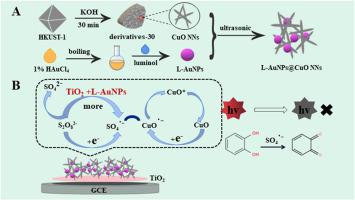Our official English website, www.x-mol.net, welcomes your feedback! (Note: you will need to create a separate account there.)
Binary-amplifying electrochemiluminescence sensor for sensitive assay of catechol and luteolin based on HKUST-1 derived CuO nanoneedles as a novel luminophore
Talanta ( IF 6.1 ) Pub Date : 2024-03-07 , DOI: 10.1016/j.talanta.2024.125836 Beibei Wang , Wenrui Zhao , Lin Wang , Kai Kang , Xianrui Li , Duo Zhang , Jujie Ren , Xueping Ji
Talanta ( IF 6.1 ) Pub Date : 2024-03-07 , DOI: 10.1016/j.talanta.2024.125836 Beibei Wang , Wenrui Zhao , Lin Wang , Kai Kang , Xianrui Li , Duo Zhang , Jujie Ren , Xueping Ji

|
Herein, a highly novel and effective electrochemiluminescence (ECL) sensor based on metal-organic framework (MOF, HKUST-1) derived CuO nanoneedles (HKUST-1 derived CuO NNs), gold nanoparticles (AuNPs) and TiO was developed for ultrasensitive detection of catechol and luteolin. The HKUST-1 derived CuO NNs were employed as luminophore for the first time, which were successfully fabricated by using HKUST-1 as precursor. The results revealed that the HKUST-1 derived CuO NNs exhibit excellent ECL activity ascribed to its abundant active site and the high specific surface area, thus obviously promoting the separation and transfer of charge and further improving the current density of ECL sensor. To binary-amplify the signal of the ECL sensor, the AuNPs and TiO nano-materials with good biocompatibility, great electron transport efficiency and high catalytic activity were used as co-reaction accelerators in the ECL process. Dependent on the above brilliant strategy, the proposed ECL sensor achieved wide linear ranges from 3 × 10 – 1 × 10 M for catechol and 1 × 10 – 2 × 10 M for luteolin, with the detection limits of 1.5 × 10 M for catechol and 5.3 × 10 M for luteolin, respectively. Furthermore, the ECL sensor exhibited outstanding selectivity, repeatability, stability and obtained great feedback on determination of catechol and luteolin in actual samples. The method not only filled a gap in the ECL application of MOF-derived materials but also provided a novel sight for design other highly efficient luminescent materials.
中文翻译:

基于 HKUST-1 衍生的 CuO 纳米针作为新型发光体的二元放大电化学发光传感器,用于灵敏测定儿茶酚和木犀草素
在此,开发了一种基于金属有机框架(MOF,HKUST-1)衍生的 CuO 纳米针(HKUST-1 衍生的 CuO NNs)、金纳米颗粒(AuNPs)和 TiO 的高度新颖且有效的电化学发光(ECL)传感器,用于超灵敏检测儿茶酚和木犀草素。 HKUST-1衍生的CuO NNs首次被用作发光体,并以HKUST-1为前驱体成功制备。结果表明,HKUST-1衍生的CuO NNs由于其丰富的活性位点和高比表面积而表现出优异的ECL活性,从而明显促进电荷的分离和转移,并进一步提高ECL传感器的电流密度。为了对ECL传感器的信号进行二元放大,采用生物相容性好、电子传输效率高、催化活性高的AuNPs和TiO纳米材料作为ECL过程中的共反应加速剂。依靠上述出色的策略,所提出的 ECL 传感器实现了儿茶酚 3 × 10 – 1 × 10 M 和木犀草素 1 × 10 – 2 × 10 M 的宽线性范围,儿茶酚和木犀草素的检测限为 1.5 × 10 M木犀草素分别为 5.3 × 10 M。此外,ECL传感器表现出出色的选择性、重复性和稳定性,在实际样品中儿茶酚和木犀草素的测定中获得了良好的反馈。该方法不仅填补了MOF衍生材料ECL应用的空白,而且为设计其他高效发光材料提供了新的思路。
更新日期:2024-03-07
中文翻译:

基于 HKUST-1 衍生的 CuO 纳米针作为新型发光体的二元放大电化学发光传感器,用于灵敏测定儿茶酚和木犀草素
在此,开发了一种基于金属有机框架(MOF,HKUST-1)衍生的 CuO 纳米针(HKUST-1 衍生的 CuO NNs)、金纳米颗粒(AuNPs)和 TiO 的高度新颖且有效的电化学发光(ECL)传感器,用于超灵敏检测儿茶酚和木犀草素。 HKUST-1衍生的CuO NNs首次被用作发光体,并以HKUST-1为前驱体成功制备。结果表明,HKUST-1衍生的CuO NNs由于其丰富的活性位点和高比表面积而表现出优异的ECL活性,从而明显促进电荷的分离和转移,并进一步提高ECL传感器的电流密度。为了对ECL传感器的信号进行二元放大,采用生物相容性好、电子传输效率高、催化活性高的AuNPs和TiO纳米材料作为ECL过程中的共反应加速剂。依靠上述出色的策略,所提出的 ECL 传感器实现了儿茶酚 3 × 10 – 1 × 10 M 和木犀草素 1 × 10 – 2 × 10 M 的宽线性范围,儿茶酚和木犀草素的检测限为 1.5 × 10 M木犀草素分别为 5.3 × 10 M。此外,ECL传感器表现出出色的选择性、重复性和稳定性,在实际样品中儿茶酚和木犀草素的测定中获得了良好的反馈。该方法不仅填补了MOF衍生材料ECL应用的空白,而且为设计其他高效发光材料提供了新的思路。



























 京公网安备 11010802027423号
京公网安备 11010802027423号